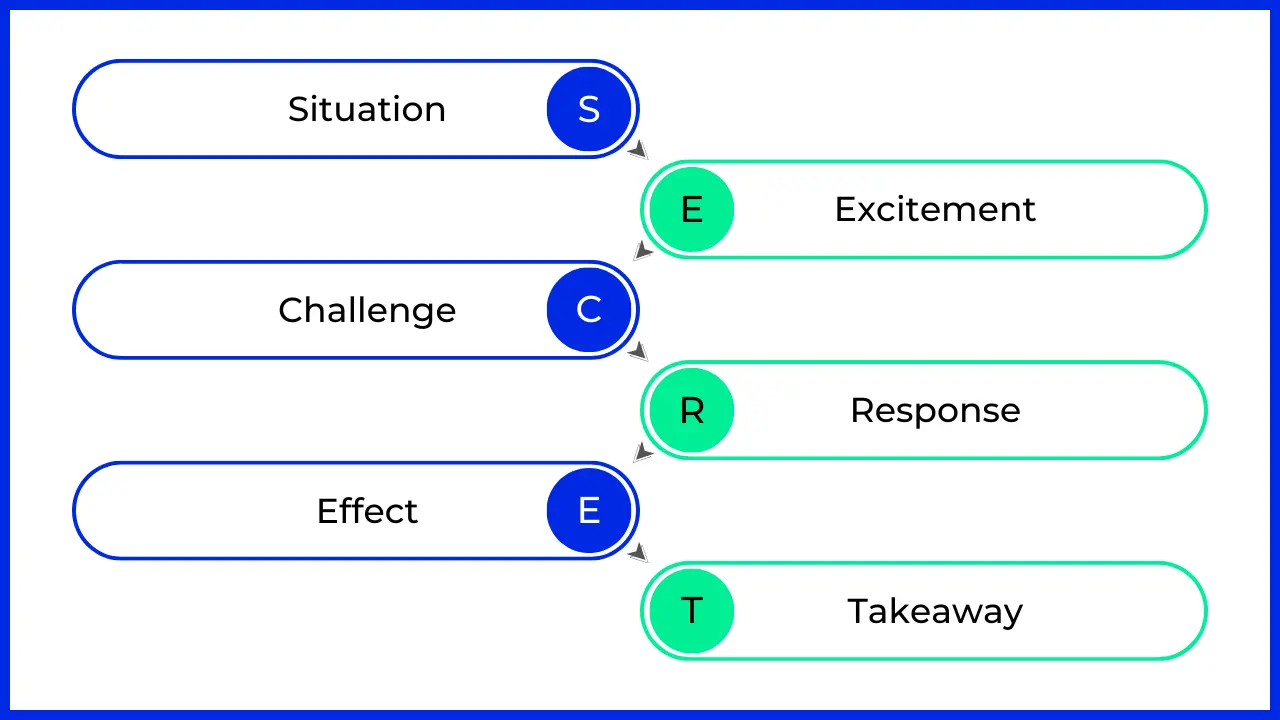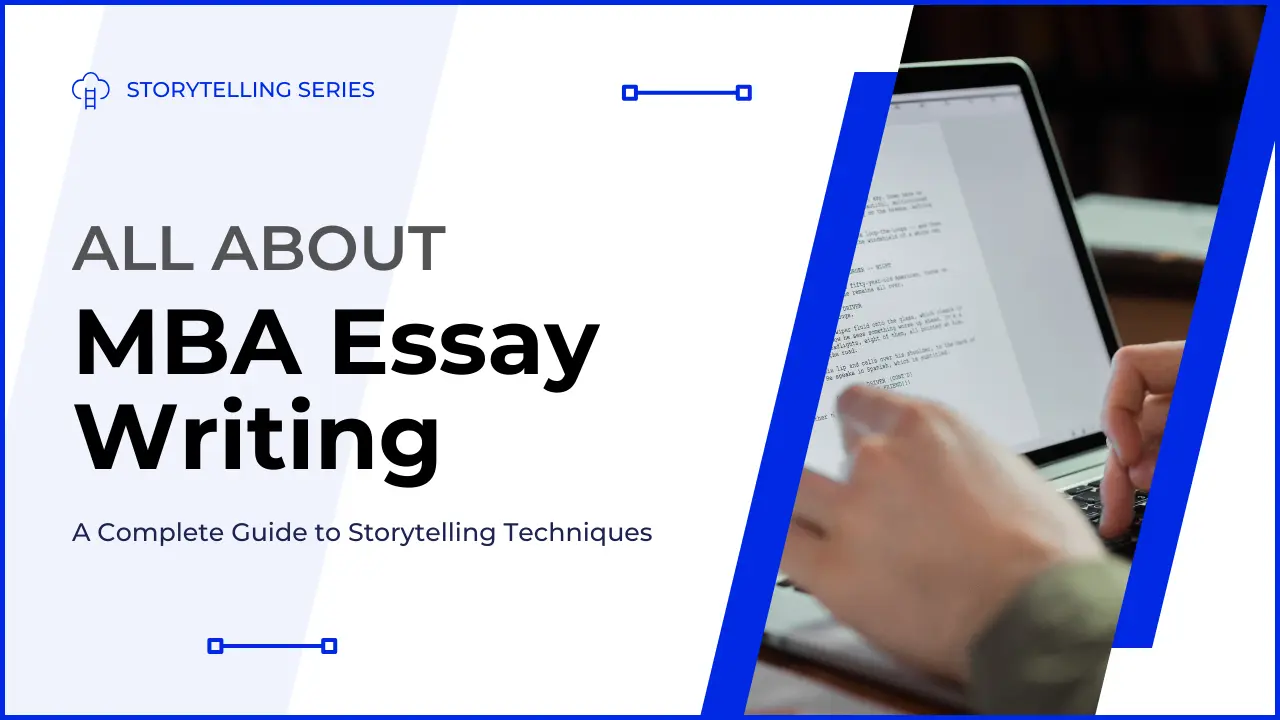Ever stared at a blank Word document, cursor blinking, while trying to write your MBA essay?
Trust me, you’re not alone.
Here’s a shocking stat:
80% of MBA applicants struggle to make their essays stand out.
But here’s the kicker: The difference between a forgettable essay and one that gets you that coveted IIM or Harvard interview?
It’s all in the storytelling.
And that’s exactly what you’re about to master.
In this ultimate guide, you’ll discover:
- The “SECRET” framework that turns bland experiences into admission-winning stories
- How to build a “story bank” that makes essay writing a breeze (even if you think you have nothing interesting to say)
- The “Chai pe Charcha” technique for making your essays unforgettable
And a whole lot more.
But first, let’s address the elephant in the room:
Why Most MBA Essays Fail
If you’re like most Indian applicants, you’ve probably got a solid academic record and decent work experience, and a job as a consultant from a Big 4 firm.
But here’s the problem:
So does everyone else.
Your essay is your chance to stand out. To show the Adcom (Admissions committee) why YOU deserve that seat more than the thousands of other applicants.
And that’s where storytelling comes in.
At Crackverbal, we’ve helped thousands of Indian applicants crack the MBA essay code.
And we’ve distilled all that knowledge into this guide.
Ready to turn your experiences into stories that make admissions officers sit up and take notice?
Let’s dive in.
Decoding MBA Essay Prompts: What Are They Really Asking?
Ever felt like MBA essay prompts are written in some secret code?
You’re not far off.
Here’s the deal:
Behind every MBA essay prompt is a hidden question. Your job? Crack that code.
Let’s break down some common prompts:
- “What are your career goals?” What they’re really asking: “Do you have a realistic plan for using our MBA?”
- “Tell us about a time you faced a challenge.” The real question: “How do you handle tough situations? Are you resilient?”
- “Why our school?” Translation: “Have you done your homework? Do you really know us?”
See the pattern?
Each prompt is a window into a different aspect of your personality and potential.
But here’s where most applicants go wrong:
They answer the surface question, missing the deeper insight the Adcom is looking for.
Don’t be that applicant.
In the next section, we’ll unveil a powerful framework that’ll help you nail the real question every single time.
Ready to become an MBA essay prompt detective?
Let’s keep going!
Start Your MBA Journey with a Free Profile Evaluation Today
Start Your MBA Journey with a Free Profile Evaluation Today
The SECRET Framework: Your MBA Essay Superpower
Alright, future MBA rockstar! You’ve cracked the code of essay prompts. Now what?
It’s time to unleash your secret weapon: The SECRET Framework.
(And no, we’re not just yelling. It’s an acronym. Stick with me here.)
S – Situation
E – Excitement
C – Challenge
R – Response
E – Effect
T – Takeaway
Think of it as the Bollywood formula for MBA essays. Every blockbuster needs these elements, and so does your essay.
Let’s break it down:

S – Situation
Set the scene. Where were you? What was happening?
❌ Bad example: “I was at work.”
✔️ Good example: “It was 2 AM, and I was staring at a glitching server that could cost our startup lakhs if not fixed by morning.”
See the difference? One puts you to sleep, the other hooks you in.
E – Excitement
What got you pumped? What was at stake?
❌ Bad example: “I was excited about the project.”
✔️ Good example: “This project could either skyrocket my career or send me back to square one. The adrenaline was real!”
C – Challenge
What hurdle did you face? What made it tough?
❌ Bad example: “It was difficult.”
✔️ Good example: “With zero budget, a team spread across three time zones, and a deadline tighter than a Mumbai local train at rush hour, this was my Everest.”
R – Response
What did you do? Be specific!
❌ Bad example: “I worked hard to solve it.”
✔️ Good example: “I rallied the team on a midnight Zoom call, delegated tasks based on time zones, and personally coded for 36 hours straight, fueled by nothing but chai and determination.”
E – Effect
What happened as a result? Quantify if possible!
❌ Bad example: “The project was successful.”
✔️ Good example: “We launched on time, acquired 10,000 users in the first week, and got featured in YourStory. The CEO called it a ‘game-changer’ for the company.”
Now that’s an effect that makes Adcoms sit up and take notice!
T – Takeaway
What did you learn? How did it change you?
❌ Bad example: “I learned a lot.”
✔️ Good example: “This experience taught me that leadership isn’t about having all the answers, but about empowering your team to find them together. It’s a lesson I’ll carry into my MBA and beyond.”
See how it all comes together? That’s the power of the SECRET framework.
But here’s the million-rupee question:
How do you find these stories in your own life?
Glad you asked! It’s time to build your Story Bank.
Building Your MBA Story Bank: Turn Your Life into Essay Gold
Picture this:
It’s 11 PM. You’re staring at the essay prompt, wracking your brain for that perfect story.
Sound familiar?
Here’s the truth bomb: Great MBA essays aren’t written. They’re assembled.
And your Story Bank is your personal Lego set for building killer essays.
Here’s how to create yours:
- Grab a chai ☕ (or coffee, we don’t judge)
- Open a spreadsheet (or go old school with pen and paper)
- Set a timer for 20 minutes
- List EVERY professional and personal experience you can think of
Don’t hold back.
That time you organized a flash mob for your college fest? Put it down.
The day you convinced your traditional parents to let you pursue an offbeat career?
That’s gold.
The project where everything went wrong, but you learned a ton? Jackpot!
Now, here’s where the magic happens:
For each experience, jot down:
- The situation (2-3 words)
- The main challenge
- Your action
- The result
- The lesson learned
Congrats! You’ve just created your MBA Story Bank.
But we’re not done yet. Here’s the secret sauce:
Categorize each story based on the qualities it showcases:
- Leadership
- Innovation
- Teamwork
- Resilience
- Global Mindset
Why? Because now, when you get that essay prompt asking about your leadership experience, you don’t panic. You’ve got 5 stories ready to go!
At Crackverbal, we’ve seen hundreds of applicants go from “I have nothing to write about” to “Which of these awesome stories should I choose?” with this technique.
Pro Tip: Keep adding to your Story Bank. Make it a habit. That project you’re working on right now? It could be your ticket to Harvard Business School!
Remember: Your experiences are unique. Your stories are powerful. And with the SECRET framework and your Story Bank, you’re armed and ready to craft essays that don’t just answer the prompt – they blow the Adcom away.
Start Your MBA Journey with a Free Profile Evaluation Today
Start Your MBA Journey with a Free Profile Evaluation Today
Tailoring Your Stories: One Size Doesn’t Fit All
Alright, future MBA mogul! You’ve got your Story Bank loaded with gems and you’re armed with the SECRET framework. You’re ready to conquer those essays, right?
Not so fast!
Here’s a truth bomb for you:
Sending the same essay to IIM Ahmedabad and Harvard Business School is like wearing a kurta to a black-tie event. It just doesn’t fit.
But don’t panic! I’m about to show you how to tailor your stories faster than your neighborhood darzi.
The Goldilocks Principle of MBA Essays

Remember Goldilocks? She didn’t want porridge too hot or too cold. She wanted it just right.
That’s exactly what the Adcom is looking for – stories that are ‘just right’ for their school.
Here’s how to nail it:
1. Do Your Homework (and no, we don’t mean JEE prep)
Before you write a single word, dig deep into the school’s:
- Core values
- Key programs
- Recent initiatives
- Famous alumni
Pro tip: Don’t just skim the website. Stalk their social media, read student blogs, chat with alums. Be the Sherlock Holmes of B-school research!
2. Find Your Hook
For each school, identify:
- What makes them unique
- How they’re different from their competitors
- What kind of students they seem to love
Example: Kellogg is crazy about teamwork. Wharton worships analytical skills. MIT Sloan is mad for innovators.
3. Connect the Dots
Now, here’s where the magic happens.
Look at your Story Bank and ask:
- Which of my stories best showcase the qualities this school values?
- How can I tweak my story to highlight aspects that align with this school’s culture?
Let’s see it in action:
Say you’re applying to ISB and INSEAD.
For ISB: Highlight how your experience starting a chai stall in college showcases your entrepreneurial spirit and understanding of Indian markets.
For INSEAD: Tweak the same story to emphasize how you collaborated with international students, showcasing your global mindset. Same story, different flavor!
4. Speak Their Language
Every school has its buzzwords. Use them (but don’t overdo it)!
- If the school talks about “transformative experiences”, show how your story transformed you.
- If they rave about “innovative leadership”, highlight how your actions were both innovative and showcased leadership.
- If “global perspective” is their jam, sprinkle in how your experience relates to international business.
But remember: Don’t force it. If you start sounding like a B-school brochure, you’ve gone too far!
5. The Secret Sauce: Show, Don’t Tell
Here’s where most applicants drop the ball.
They say, “I’m a perfect fit for your school because…” Snooze fest alert! 😴
Instead, SHOW them you’re a fit through your stories.
❌ Bad example: “I’m passionate about entrepreneurship, which aligns with Stanford’s values.”
✔️ Good example: “When I turned my mom’s pickle business into a thriving e-commerce startup, I realized I needed the skills Stanford’s Startup Garage could offer to take it global.”
See the difference? One tells, the other sells!
Start Your MBA Journey with a Free Profile Evaluation Today
Crafting Killer Essays: From Hook to Mic Drop
Alright, future B-school legend! You’ve got your stories ready and tailored for each school. Now it’s time for the main event: actually writing that essay that makes the
Adcom go “Wow!”
But here’s the cold, hard truth:
Most MBA essays are about as exciting as watching paint dry in Delhi summer.
Ouch, right? But don’t worry, I’m about to show you how to turn your essay into a page-turner that the Adcom can’t put down.
The 5-Second Hook: Make Them Want More
Picture this: An Adcom member is sifting through their 50th application of the day.
Their eyes are glazing over. They reach for your essay and…
BAM! Your first line hits them like an auto rickshaw in Bangalore traffic.
That’s the power of a great hook. You’ve got 5 seconds to grab their attention. Make ’em count!
Here’s how:
1. Start with a bang, not a whimper
Boring: “I am writing this essay to apply for your MBA program.” (Well, duh! They know that already.)
Exciting: “The day I accidentally crashed the stock market simulation, I knew finance was my calling.” (Wait, what? Tell me more!)
2. Use the “Movie Trailer” technique
Think of your first line as a movie trailer. It should give a taste of the excitement to come, without giving everything away.
Example: “Three years ago, I was a failed entrepreneur with ₹50,000 in debt and a broken dream. Today, I’m leading a team of 50 at a unicorn startup. Here’s how it happened…”
Now that’s a story I want to read!
3. Ask a thought-provoking question
Get their mental gears turning right from the start.
Example: “What would you do if you had to choose between your dream job and saving your family business?”
Boom! They’re hooked.
Keeping Them Hooked: The “Spice Mix” Principle

Ever noticed how a good biryani keeps you coming back for more? Each bite leaves you craving the next.
That’s exactly how your essay should flow. Here’s how:
1. Use the “One Punch” Paragraph
Keep your paragraphs short and punchy. One idea, one paragraph.
Long paragraphs are where attention goes to die. Don’t kill your reader’s interest!
2. Employ the “Curiosity Gap”
End each paragraph with a little cliffhanger that makes them want to read the next one.
Example: “Little did I know, that decision would change everything…”
3. Sprinkle in some “Masala”
Use vivid details and sensory language to bring your story to life.
Bland: “The project was challenging.”
Spicy: “With a team spread across three time zones, a budget tighter than an economy class seat, and a deadline breathing down our necks, this project was showing all signs of being my nemesis.”
4. The “Chai Break” Technique
Every few paragraphs, give your reader a moment to digest what they’ve read. A short reflection or a pivotal question works great.
Example: “In that moment, I realized leadership isn’t about having all the answers. It’s about…”
Start Your MBA Journey with a Free Profile Evaluation Today
Start Your MBA Journey with a Free Profile Evaluation Today
The Grand Finale: Stick the Landing
1. Bring It Full Circle
Reference your opening hook. Show how far you’ve come.
Example: “From crashing a stock market simulation to leading a ₹100 crore portfolio, my journey in finance has been anything but conventional. But it’s precisely this rollercoaster ride that’s prepared me for the challenges of your MBA program and beyond.”
2. The “So What?” Test
Answer the question: “So what does this all mean for your future MBA journey and career?”
Don’t just recap what you’ve done. Show how it’s shaped you and how it connects to your future goals.
Example: “These experiences haven’t just taught me about finance; they’ve shown me the power of resilience, innovation, and ethical leadership. These are the qualities I aim to further develop at [School Name], contributing my unique perspective to classroom discussions and learning from the diverse experiences of my peers.”
Here’s another example: “As I stand at this crossroads, ready to take the next leap in my journey, I’m excited about the possibilities that lie ahead at [School Name]. I’m not just seeking an MBA; I’m looking to be part of a transformative experience that will shape the future of business in India and beyond. And I can’t wait to bring my passion for innovative finance solutions to your classroom, your startup incubator, and eventually, to the emerging markets that need it most.”
The Secret Weapon: Emotion + Logic

Here’s a trick we swear by at Crackverbal: The best MBA essays balance emotion and logic.
They tell a compelling story (emotion) while also showcasing your achievements and fit with the program (logic).
Think of it like a Bollywood blockbuster. You need the emotional drama to keep people engaged, but you also need a solid plot to tie it all together.
Here’s how to strike that balance:
1. The Emotional Core
Start by identifying the emotional heart of your story.
What drives you? What challenges have you overcome? What moments have defined your journey?
Example: “The day I saw my father’s small business crumble under poor financial management, I knew I had to do something. That mix of helplessness and determination became the fuel for my finance career.”
2. The Logical Framework
Now, build the logical structure around that emotional core. Show how your emotional journey has led to concrete achievements and skills that make you a great MBA candidate.
Example: “Driven by that early experience, I’ve spent the last five years building my expertise in financial management for SMEs. I’ve helped 50+ small businesses secure funding, implemented financial literacy programs that have reached 1000+ entrepreneurs, and even developed a mobile app for basic bookkeeping that’s been downloaded 10,000 times.”
3. The Future Projection
Finally, connect your emotional journey and logical achievements to your future goals and how the MBA fits into that picture.
Example: “Now, I’m ready to take my mission of financial empowerment to the next level. With [School Name]’s renowned Finance and Entrepreneurship program, I aim to gain the advanced skills and global perspective needed to develop innovative financial products for underserved markets. My ultimate goal? To launch a fintech startup that democratizes access to financial services for small businesses across Southeast Asia.”
The “Chai Pe Charcha” Review Process

You’ve written your essay. You think it’s pretty good. But before you hit that submit button, it’s time for the “Chai Pe Charcha” review process.
Here’s how it works:
1. The Friend Test
Share your essay with a friend over a cup of chai. Ask them to tell you what they understood about your story, your goals, and why you’re a good fit for the program.
If they can’t easily summarize these points, it’s time for a rewrite.
2. The Stranger Test
Now, share it with someone who doesn’t know you well. Ask them what impression they formed of you from the essay.
Is it the impression you want to give the Adcom? If not, time to revise.
3. The Time Test
Put your essay away for a week. Then read it again with fresh eyes.
Does it still excite you? Do you still agree with everything you’ve written?
If not, you know what to do.
4. The Pretend-to-be-from-the-Adcom Test
Read your essay pretending to be someone from the Adcom.
Does it answer their key questions? Does it make them want to meet you?
If not, it’s back to the drawing board.
The Crackverbal Edge: Professional Essay Review
Still not sure if your essay is Adcom-ready? Don’t stress.
At Crackverbal, we offer professional essay reviews that can take your writing from good to great. Our experts have years of experience and know exactly what top B-schools are looking for.
Pro tip: Read your essay out loud. If you stumble over any sentences or run out of breath, that’s a sign you need to simplify and clarify.
Your Mission: The Essay Makeover Challenge
Ready to put all this into practice? Here’s your mission:
- Take an existing MBA essay you’ve written (or write a new one using the techniques we’ve discussed)
- Apply the “5-Second Hook” technique to your opening
- Use the “Spice Mix” Principle to keep the reader engaged throughout
- Craft a powerful conclusion using the “Grand Finale” tips
- Balance emotion and logic throughout your essay
- Put it through the “Chai Pe Charcha” review process
- Revise and refine until it shines!
Remember: A great MBA essay isn’t just born. It’s made through multiple drafts, ruthless editing, and a willingness to dig deep and share your authentic self.
Conclusion: Your MBA Essay Masterpiece Awaits
Congratulations, future MBA superstar!
You’ve made it through the ultimate guide to crafting compelling MBA essays. Let’s do a quick recap of your journey:
- You’ve learned to decode MBA essay prompts like a pro
- You’ve mastered the SECRET framework for powerful storytelling
- You’ve built your own Story Bank, turning your life into essay gold
- You’ve discovered how to tailor your stories for different schools
- You’ve learned the art of crafting killer essays from hook to conclusion
But here’s the thing: This is just the beginning of your MBA application journey.
Remember:
- Your unique experiences are your secret weapon. Use them wisely.
- Every story in your life, no matter how small, can be essay gold if you know how to mine it.
- The best essays aren’t written—they’re rewritten, polished, and perfected.
So, what’s next?
It’s time to put these tools into action. Get right into your Story Bank, craft those essays, and start your journey to B-school success.
But if you find yourself stuck, or if you want that extra edge to make your application truly stand out, remember: You don’t have to do this alone.
At Crackverbal, we’ve helped thousands of applicants just like you turn their unique stories into admit-winning essays. Our MBA Essay Mastery Workshop and personalized Essay Review services are designed to give you that extra boost.
Ready to transform your MBA dreams into reality?
Your next chapter awaits. Let’s write it together!





0 Comments